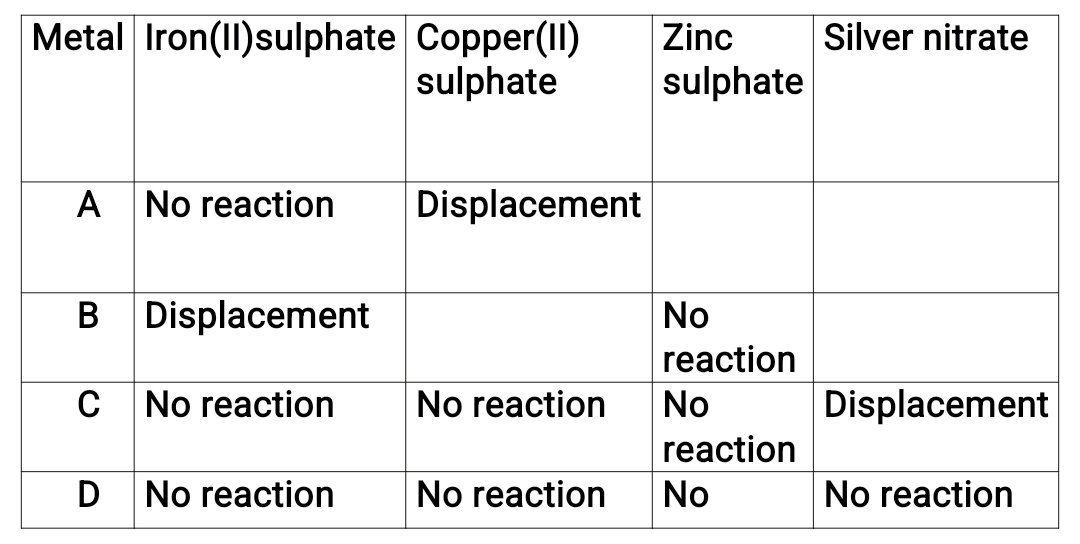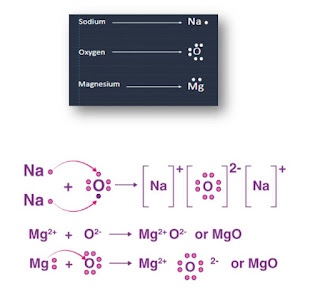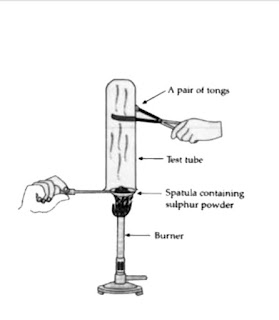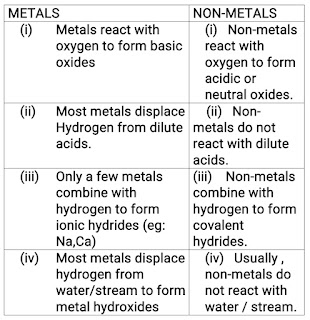Class 10 Science - Chapter 3: Metals and Non-Metals
Welcome to the solutions and notes for Chapter 3: Metals and Non-Metals.
INTEXT SOLUTIONS
PAGE 40
Q1) Give an example of metal which
- is a liquid at room temperature.
- can be easily cut with knife.
- is best conductor of heat.
- is poor conductor of heat.
Ans:-
- (i) Mercury
- (ii) Sodium
- (iii) Gold
- (iv) Lead
Q2) Explain the meaning of malleable and ductile.
Ans:- Malleable means a metal can be beaten or hammered into thin sheets without breaking. For example, aluminium and silver are malleable.
Ductile means a metal can be drawn into wires. For instance, copper and gold can be stretched into long, thin wires without snapping.
PAGE 46
Q1) Why is sodium kept immersed in kerosene oil?
ANS : Sodium is a highly reactive metal. If left in the open, it can catch fire on reacting with moisture or air. That’s why it is safely kept under kerosene oil, which blocks its contact with air and prevents accidental fire.
Q2) Write equation for the reaction of
- Iron with steam
- Calcium and potassium with water
ANS :

Q3) Samples of four metals A, B, C and D were taken and added to the following solution one by one. The results obtained have been tabulated as follows :
Use the table given above to answer the following questions about metals A,B,C and D.
- Which is the most reactive metal?
- What would you observe if B is added to a solution of Copper(II) sulphate?
- Arrange the metals A, B,C and D in order of decreasing reactivity.
ANS :
- (i) Metal B is the most reactive — it displaces both iron and copper from their solutions
- (ii) A displacement reaction will occur. Metal B will replace copper, and copper will be seen as a brown deposit in the solution.
- (iii) The decreasing order of reactivity is : B> A> C >D
Q4) Which gas is produced when dilute hydrochloric acid is added to reactive metal?
ANS : When a reactive metal reacts with dilute hydrochloric acid, hydrogen gas is released, and a metal salt is formed.
Fe(s) + H₂SO₄(aq) ----> FeSO₄(aq) + H₂(g)
Q5) What would you observe when zinc is added to a solution of iron(II) sulphate? Write the chemical reaction that takes place.
ANS : Zinc is more reactive than iron, so it will displace iron from the solution. You’ll see iron settling down in the solution, and the color of the solution will change.
FeSO₄ + Zn -----> ZnSO₄ + Fe
PAGE 49
Q1) (i) Write the electron-dot for sodium , oxygen and magnesium.
(ii) Show the formation of Na₂O and MgO by the transfer of electrons.
(iii) What are the ions present in these compounds ?
ANS :
(i) Sodium : 2,8,1
Oxygen : 2,8,6
Magnesium : 2,8,2
(ii)

(iii) Ions present in Na₂O are Na⁺ and O²⁻. And ions present in MgO are Mg²⁺ and O²⁻ .
Q2) Why do ionic compounds have high melting points?
ANS : Ionic compounds are made of positively and negatively charged ions held together by strong electrostatic attraction. A large amount of energy is needed to break these forces, so their melting points are very high.
PAGE 53
Q1) Define the following terms :
- Minerals
- Ores and
- Gangue
ANS :
- (i) A mineral is a naturally found substance in the earth’s crust that contains a metal or its compounds in a form from which it might be extracted profitably.
- (ii) An ore is a mineral that contains a high percentage of metal and can be processed economically to extract that metal
- (iii)Gangue refers to unwanted earthy materials or impurities such as sand, clay, etc., that are found mixed with ores and must be separated during extraction.
Q2) Name two metals which are found in nature in the free state.
ANS : Metals like gold and platinum are usually found in their pure or native form in nature because they are highly unreactive.
Q3) What chemical process is used for obtaining a metal from its oxide?
ANS : To extract metal from its oxide, a process called reduction is used. This involves removing oxygen from the metal oxide using a reducing agent like carbon (coke) or by electrolysis, depending on the reactivity of the metal.
PAGE 55
Q1) Metallic oxides of zinc , magnesium and copper were heated with the following metals.
In which of the following cases will you find displacement reactions taking place ?
ANS :

Q2) Which metals do not corrode easily ?
ANS : Metals like gold, platinum, and aluminium do not corrode easily. Gold and platinum are less reactive, hence they resist corrosion. Aluminium, though reactive, forms a protective oxide layer on its surface that prevents further corrosion.
Q3) What are alloys ?
ANS : Alloys are mixtures of two or more metals or a metal and a non-metal. They are made to improve properties like strength, resistance to corrosion, hardness, and appearance.
For example:
- Brass = Copper + Zinc
- Bronze = Copper + Tin
- Stainless Steel = Iron + Carbon + Chromium + Nickel
EXERCISES SOLUTION
Q1) Which of the following pairs will give displacement reactions?
- NaCl solution and copper metal
- MgCl₂ solution and aluminium
- FeSO₄ solution and silver metal
- AgNO₃ solution and copper
ANS :(b) MgCl₂ solution and aluminium
Q2) Which of the following method is suitable for preventing an iron fry pan from rusting?
- Applying grease
- applying paint
- Applying coating of zinc
- All of the above
ANS : (d) All of the above
Q3) An element reacts with oxygen to give a compound with a high melting point. This compound is also soluble in water. The element is likely to be
- Calcium
- Carbon
- Silicon
- Iron
ANS : (a) Calcium
Q4) Food cans are coated with tin and not zinc because
- Zinc is costlier than tin
- Zinc has higher melting point
- Zinc is more reactive than tin
- Zinc is less reactive than tin
ANS : (c) Zinc is more reactive than tin
Q5) You are given a hammer, a battery, a bulb, wires and switch.
- How could you use them to distinguish between samples of metals and non-metals ?
- Asses the usefulness of these tests in distinguishing between metals and non-metals?
ANS :
(a) : Hammer test: Metals are malleable and can be flattened without breaking, while non-metals are brittle.
Electricity test: Metals conduct electricity, so if connected to a circuit (battery, bulb, wires), the bulb will glow. Non-metals will not complete the circuit
(b) These tests are useful and simple methods to check basic properties like malleability and electrical conductivity, which clearly distinguish metals from non-metals.
Q6) What are amphoteric oxides? Give two examples of amphoteric oxides.
ANS : Oxides that can react with both acids and bases to form salt and water are called amphoteric oxides.
Eg : Aluminum oxide, zinc oxide
Q7) Name two metals which will displace hydrogen from dilute acids, and two metals which will not.
ANS : Metals that displace hydrogen from acids: Zinc, Iron
Metals that do not displace hydrogen from acids: Copper, Silver
Q8) In the electrolytic refining of a metal M, what would you take as the anode, the cathode and the electrolyte?
ANS : Impure metal M is made the anode, thin strips of pure metal M as cathode and a salt solution of metal M as electrolyte.
Q9) Pratyush took Sulphur powder on spatula and heated it. He collected the gas evolved by inverting a test tube over it as shown in fig. below :

- What will be the action of gas on
- Dry litmus paper?
- Moist litmus paper?
- Write a balanced chemical equation for the reaction taking place.
ANS :
(a) In this case sulphur dioxide is produced which is acidic in nature.
- (i) No action on dry litmus paper
- (ii) wet litmus paper will turn red.
(b) S + O₂ -----> SO₂
Q10) State two ways to prevent the rusting of iron.
ANS : Rusting of iron can be prevented by
- (i) By applying grease or paint on the iron.
- (ii) By galvanizing (coating of zinc layer) it.
Q11) What types of oxides are formed when non-metals combine with oxygen?
ANS : Acidic oxides are formed.
Q12) Give reasons :
- Platinum, gold and silver are used to make jewellery.
- Sodium, potassium and lithium are stored under oil.
- Aluminum is highly reactive metal, yet it is used to make utensils for cooking.
- Carbonate and sulphides ores are usually converted into oxides during the process of extraction.
ANS :
- (a) These metals are shiny, malleable, and do not corrode easily.
- (b) These metals react quickly with air and water, so they are stored under oil to prevent reactions.
- (c) It forms a protective oxide layer that prevents further reaction, making it safe and durable for use.
- (d) Oxides are easier to reduce to pure metal compared to carbonates or sulphides.
Q13) You must have seen tarnished copper vessels being cleaned with lemon or tamarind juice. Explain why these sour substances are effective in cleaning the vessels.
ANS : Lemon or tamarind juice contains acids (like citric or tartaric acid) that react with copper oxide coating and dissolve it, cleaning the surface.
Q14) Differentiate between metal and non-metal on the basis of their chemical properties.
ANS :

Q15) A man went door to door posing as a goldsmith. He promised to bring back the glitter of the old and dull ornaments. An unsuspecting lady gave a set of gold bangles to him which he dipped in a particular solution. The bangles sparkled like new but their weight was reduced drastically. The lady was upset but after a futile argument the man beat a hasty retreat. Can you play the detective to find out the nature of the solution he had used?
ANS : The man likely used a solution of aqua regia (a mixture of hydrochloric acid and nitric acid). It dissolves a small layer of gold, making it look shiny. But since gold is lost from the bangle, its weight decreased
Q16) Give reasons, why copper is used to make hot water tanks and not steel (an alloy of iron).
ANS : Copper is a better conductor of heat and does not rust easily. Steel (iron alloy) can rust when in contact with water and oxygen over time.